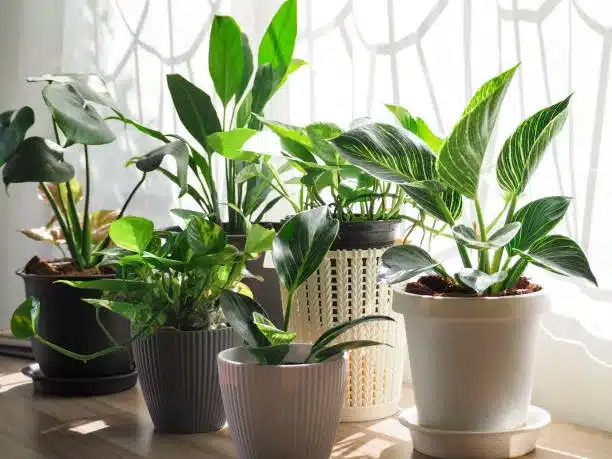Thriving house plants can transform any space into a vibrant, lively area. But for beginners, the journey to lush, healthy indoor greenery might seem filled with mystery. Fear not! This guide is your key to unlocking the secrets of thriving houseplants.
Understanding Your Houseplants
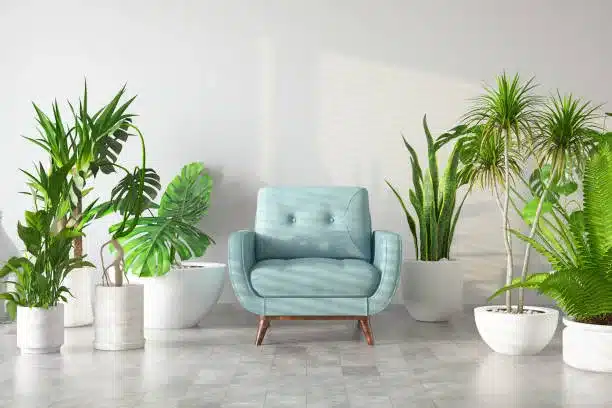
The Basics of Houseplant Biology
Understanding the basics of how your plants live and grow is crucial. Photosynthesis isn’t just a word from your high school biology class; it’s the process that keeps your plants alive. Knowing whether your green buddy is a sun-lover or a shade-seeker is fundamental to its survival.
Knowing Your Plant’s Origins
Your Monstera and cactus don’t just differ in looks; their needs are as different as their natural habitats. Grasping where your plant comes from helps you replicate those conditions at home, be it a tropical rainforest or arid desert.
Essential Care for Houseplants
Light: The Key to Growth
Light is to plants what food is to us. But not all plants crave sunlight in the same way. Some flourish in direct sunlight, while others prefer the shade. This section will guide you on how to determine and provide the perfect amount of light for your plant.
Understanding Light Requirements
Types of Light Exposure
- Direct Sunlight: This is unfiltered sunlight coming directly through a window. Plants like cacti and succulents thrive here.
- Indirect Sunlight: Bright yet indirect light is perfect for many houseplants. It’s bright but not harsh.
- Low Light: Some plants, like the snake plant, can survive in lower light conditions. This doesn’t mean no light, but rather, away from direct sunlight sources.

Reading Your Plant’s Light Needs
- Labels and Guides: Most plants come with care labels indicating their light needs. Always start here.
- Observation: Look for signs of too much or too little light. For example, leggy stems or faded leaves suggest a need for more light.
Assessing Your Home’s Light
Using Natural Light
- Window Direction: North-facing windows get less intense light. South-facing windows offer the most light. East and West can vary.
- Time of Day: Understand when your rooms get the most light. Morning light is different in intensity and quality from afternoon light.
Artificial Lighting
- Grow Lights: In spaces with inadequate natural light, grow lights can be a game changer. They’re especially useful in winter months.
- Light Bulbs: Look for full-spectrum bulbs that mimic natural sunlight.
Adjusting Light for Your Plants
Seasonal Changes
- Summer vs. Winter: Light intensity and duration change with seasons. You might need to move plants or adjust artificial lighting accordingly.
- Protecting from Intense Sun: In summer, sheer curtains can protect plants from scorching in direct sunlight.
Practical Tips for Optimal Lighting
- Rotate Plants: Regularly rotate your plants to ensure even light exposure.
- Layering Plants: Place taller plants nearer to the light source and underplant with those requiring less light.
- Reflection: Use mirrors or other reflective surfaces to increase light in darker areas.
By understanding and optimizing the light available in your home, you can significantly improve the health and growth of your houseplants. Remember, each plant is unique, so take the time to observe and adjust to their individual needs.
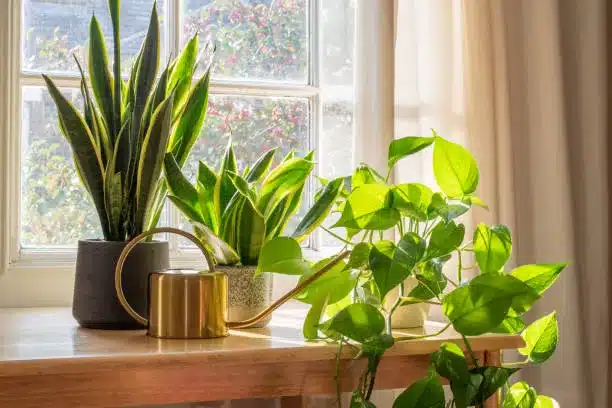
Watering Wisely
Watering your plants correctly is perhaps the most essential skill in houseplant care. Overwatering is a common mistake, but with these tips, you’ll learn to water just right, whether you’re caring for a moisture-loving fern or a drought-tolerant succulent.
Understanding Water Needs
Signs of Overwatering and Underwatering
- Overwatering: Yellowing leaves, soft and mushy stems or leaves, and mold or fungus gnats can all be signs of too much water.
- Underwatering: Drooping, dry, and crispy leaves are tell-tale signs your plant is thirsty.
Plant-Specific Water Needs
- Different plants have varying water requirements. For example, ferns and peace lilies prefer consistently moist soil, while succulents and cacti thrive in dry conditions.
Tips for Proper Watering
Checking Soil Moisture
- Finger Test: Insert your finger about an inch into the soil. If it’s dry, it’s time to water.
- Moisture Meters: These tools can help take the guesswork out of watering, especially for larger plants.

Water Quality and Temperature
- Room Temperature Water: Cold water can shock plant roots. Use room temperature water for most houseplants.
- Filtered or Rainwater: Some plants are sensitive to chemicals in tap water. Consider using filtered or collected rainwater.
Techniques for Watering
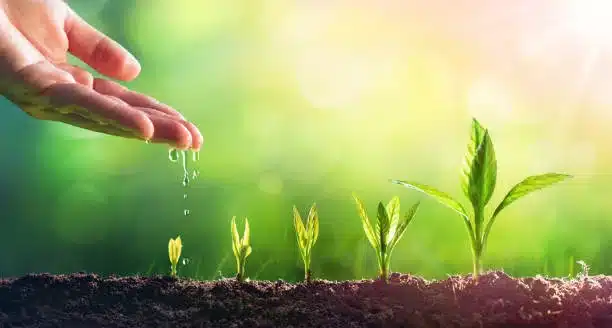
Bottom Watering
- This method allows the plant to absorb water through the drainage holes. It’s particularly effective for plants that don’t like water on their leaves.
Watering Evenly
- Ensure water reaches all parts of the soil. Uneven watering can leave parts of the root system dry.
Adjusting for Seasons and Environment
- Plants typically need less water in the winter and more in the growing season. Also, consider environmental factors like humidity and temperature, which can affect how quickly soil dries out.
Advanced Watering Tips
Grouping Plants with Similar Needs
- Placing plants with similar watering needs together can make your watering routine more efficient and effective.
Mulching for Moisture Retention
- A layer of mulch on the soil surface can help retain moisture, reducing the need for frequent watering.
By mastering the art of watering, you ensure the foundation of your houseplants’ health is strong. Remember, each plant is an individual, and their needs can change over time and with the seasons, so stay observant and responsive to their needs.
related article – 10 mulching benefits unveiled
What is the purpose of mulch, and why is it so important for your garden? Mulch is a material layer spread over the surface of the… Read More >>
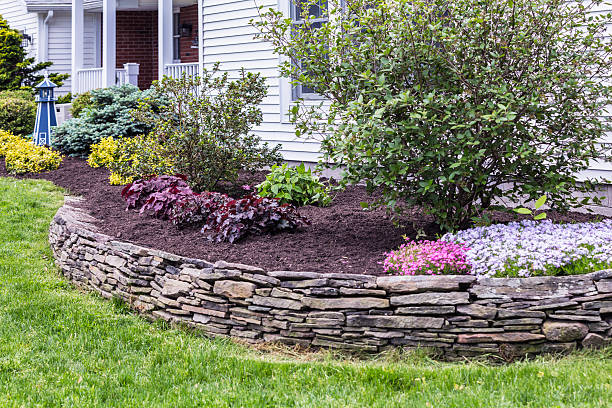
The Role of Humidity and Temperature
Just like us, plants have their comfort zones. Understanding and managing the humidity and temperature conditions in your home is key to keeping your leafy friends happy and healthy.
Understanding Plant Humidity Needs
The Importance of Humidity
- Tropical Plants: These plants, like orchids and ferns, thrive in high humidity environments.
- Desert Plants: Succulents and cacti, on the other hand, prefer dry air.
related article – secrets to repotting christmas cactus
Discover the mind-blowing secrets to successfully repotting Christmas cactus in this comprehensive guide from Our Gardening World. Learn the importance of choosing the right potting mix, timing the repotting process, and proper handling techniques. Uncover the step-by-step process to master the repotting technique and explore essential post-repotting care and maintenance tips. This expert article provides valuable … Read More>>
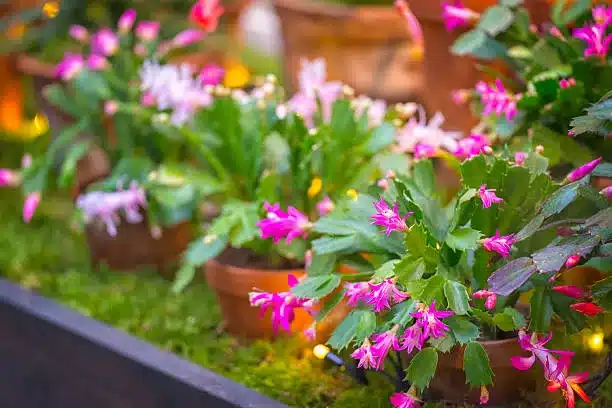
Signs of Humidity Issues
- Too Dry: Brown leaf tips and wilting can indicate air that’s too dry.
- Too Humid: Excess moisture can lead to mold growth and root rot.
Managing Humidity for Houseplants
Increasing Humidity
- Misting: Lightly misting plants can increase the local humidity but is often a temporary solution.
- Humidity Trays: Place water-filled trays with pebbles under the plant pots.
- Grouping Plants: Grouping plants together can create a microclimate with higher humidity.
Reducing Humidity
- Dehumidifiers: In overly humid environments, consider using a dehumidifier.
- Air Circulation: Ensure good air circulation with fans or open windows to reduce humidity.
Temperature Requirements for Houseplants
Ideal Temperature Range
- Daytime and Nighttime Temperatures: Most houseplants prefer temperatures between 65°F and 75°F (18°C – 24°C) during the day and slightly cooler at night.
- Understanding Plant Labels: Check the label for specific temperature needs.
Protecting Plants from Temperature Extremes
- Avoid Drafts: Keep plants away from cold drafts and hot air vents.
- Seasonal Changes: Be mindful of temperature changes, especially during seasonal transitions.
- Insulation: In winter, ensure windows are well insulated to prevent cold spots.
Adjusting Temperature and Humidity Together
- Balance is Key: Aim to balance both temperature and humidity for optimal plant health.
- Regular Monitoring: Use a thermometer and hygrometer to regularly check conditions.
By maintaining the ideal humidity and temperature conditions, you’re creating an environment where your houseplants can not only survive but thrive. It’s all about understanding what each type of plant prefers and adjusting your home environment to meet those needs.
Advanced Houseplant Care
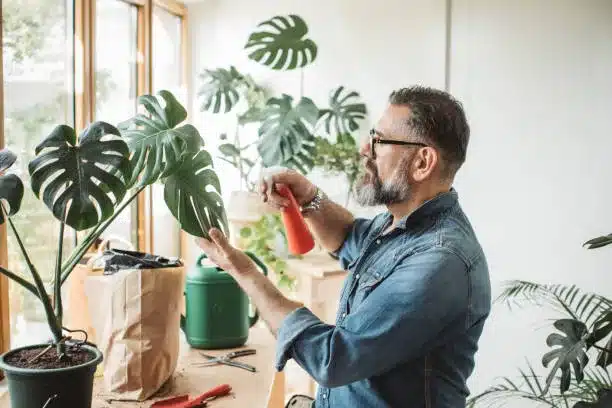
Caring for houseplants involves more than just watering and positioning them correctly. Advanced care, including choosing the right soil and pot, fertilizing appropriately, and regular pruning and grooming, is essential for thriving plants.
Choosing the Right Soil and Pot
The Importance of Soil
- Soil Types: Different plants require different soil types. Succulents prefer sandy, well-draining soil, while ferns thrive in moisture-retentive, loamy soil.
- Drainage: Good drainage is crucial to prevent root rot. Ensure your soil is not too dense and that pots have drainage holes.
Selecting the Right Pot
- Material: The material of your pot affects moisture retention. Terracotta pots are porous and allow soil to dry more quickly, while plastic pots retain moisture longer.
- Size: A pot that’s too large can lead to waterlogging, while one that’s too small can restrict growth. Choose a size that gives your plant room to grow without being excessive.
Fertilizing Fundamentals
Understanding Plant Nutrition
- Nutrient Requirements: Plants need various nutrients, including nitrogen, phosphorus, and potassium, in different amounts.
- Fertilizer Types: There are granular, liquid, and slow-release fertilizers, each suitable for different plants and purposes.
Fertilizing Techniques
- Frequency: Over-fertilizing can harm plants. Follow the recommended frequency for your specific plant species.
- Application: Apply fertilizer evenly and avoid direct contact with leaves or stems to prevent burning.
Pruning and Grooming
Benefits of Pruning
- Health: Removing dead or diseased foliage promotes healthy growth.
- Shape: Pruning helps maintain a desirable shape and size, especially in confined spaces.
Pruning Techniques
- Timing: The best time to prune most plants is during their growth period, typically in spring or early summer.
- Tools: Use sharp, clean shears or scissors to make clean cuts without damaging the plant.
- Unmatched Durability: Crafted in Switzerland, the Felco Pruning Shears (F 6) are engineered with robust materials to withstand rigorous use, ensuring you a lifelong gardening companion.
- Optimized Performance: Equipped with hardened steel blades, these pruners offer precision cutting with minimal effort, giving you a clean, damage-free cut every time to promote healthier plant growth.
- Ergonomic Design: The Felco F 6 features an ergonomic, non-slip handle that is ideal for both small and medium-sized hands, providing comfort and efficiency during long hours of pruning.
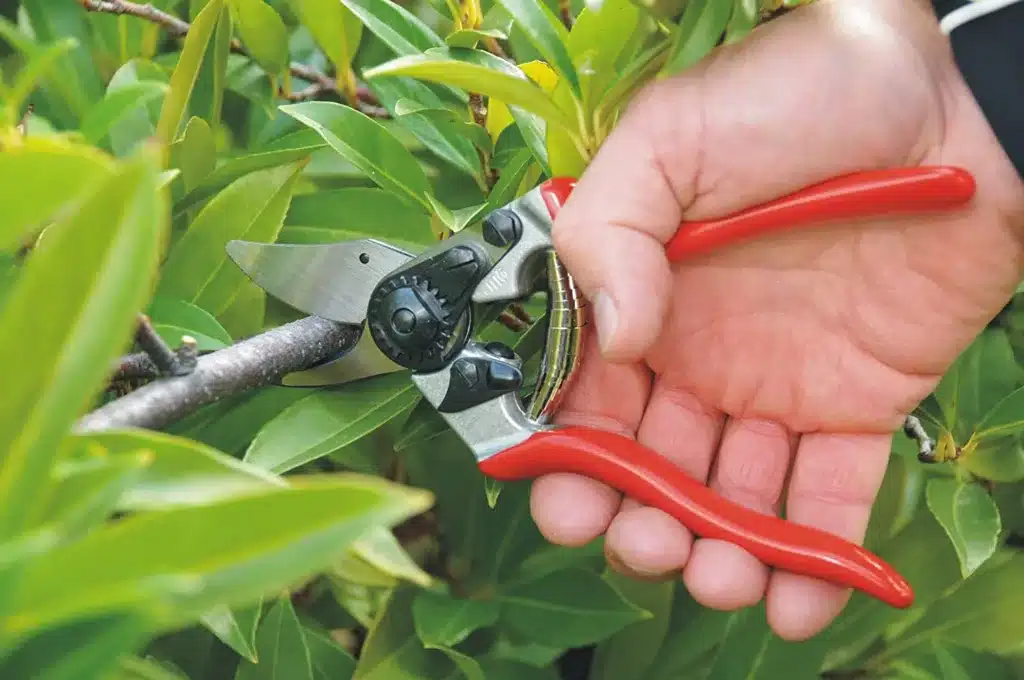
Grooming Tips
- Dusting Leaves: Regularly clean leaves to ensure effective photosynthesis.
- Checking for Pests: Regular grooming helps in early detection of pests or diseases.
Advanced care techniques like choosing the right soil and pot, fertilizing appropriately, and regular pruning and grooming are crucial for the health and appearance of your houseplants. With these practices, your plants will not only survive but flourish in your care.
Troubleshooting Common Problems
Pest and Disease Management
Identifying Pests and Diseases
- Common Pests: Look out for signs of aphids, spider mites, and mealybugs, such as sticky leaves or webbing.
- Disease Symptoms: Yellowing leaves, spots, or mildew can indicate disease.
Managing Pests and Diseases
- Natural Remedies: Neem oil, insecticidal soap, or a simple water spray can be effective against many pests.
- Chemical Treatments: Use as a last resort and follow instructions carefully to avoid harming the plant.
Reviving a Struggling Plant
Diagnosing Problems
- Watering Issues: Check if the soil is too dry or waterlogged.
- Light Exposure: Ensure the plant is getting the right amount and type of light.
Recovery Steps
- Adjust Care Routine: Modify watering, lighting, and feeding as needed.
- Pruning Damaged Parts: Remove dead or diseased foliage to encourage new growth.
Creating the Perfect Environment
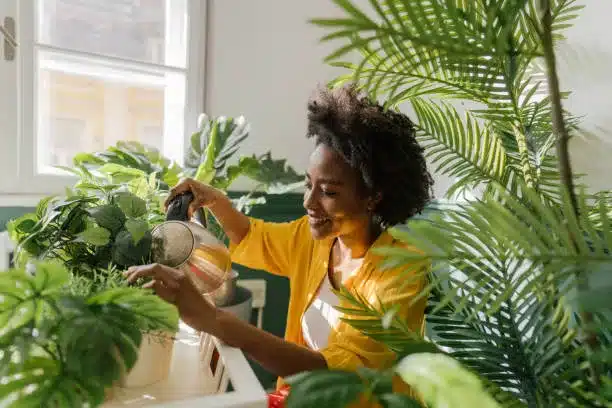
Positioning Plants in Your Home
Assessing Your Space
- Light Sources: Identify sunny and shaded areas in your home.
- Temperature Fluctuations: Avoid placing plants near heat sources or drafty windows.
Optimizing Plant Placement
- Strategic Positioning: Use shelves or hanging pots to make the most of your space.
- Grouping for Microclimates: Place humidity-loving plants together.
Regular Maintenance and Care
Creating a Care Schedule
- Watering Routine: Establish a regular watering schedule based on each plant’s needs.
- Fertilizing Calendar: Set reminders for when to feed your plants.
Seasonal Adjustments
- Winter Care: Reduce watering and stop fertilizing during dormant periods.
- Summer Care: Monitor plants for increased water needs and potential sunburn.
By addressing these common problems and creating the right environment, you can significantly enhance the health and longevity of your houseplants. Regular maintenance and an understanding of your plants’ needs are key to a thriving indoor garden.
Frequently Asked Questions About Thriving Houseplants
Houseplants can bring life and color to any indoor space, but ensuring they thrive requires some know-how. In this section, we’ll answer some common questions that people often ask about thriving houseplants.
Remember, while these plants have air-purifying abilities, having a variety of plants, good ventilation, and regular home cleaning are also crucial for maintaining good indoor air quality.
Thriving Houseplants Conclusion
Embarking on your houseplant journey might seem daunting, but armed with the right knowledge, you’re well on your way to having thriving houseplants. Remember, every plant has its unique personality and needs. Learning and adapting is part of the fun!
Additional Resources
For more in-depth information, check out The Royal Horticultural Society, a treasure trove for plant enthusiasts. And don’t forget, I’m always here to help with your gardening queries. Share your experiences and questions in the comments below!
Check Our Landscape Projects On Facebook
Hi there, I’m Mark Apletree, a gardening enthusiast with a passion for gardening, and gardening tools. I’ll be your go-to guide for all things related to gardening. The purpose of this website is to assist you in selecting the most suitable garden gear that meets your specific requirements.
See All Posts
